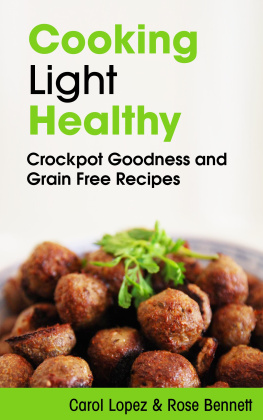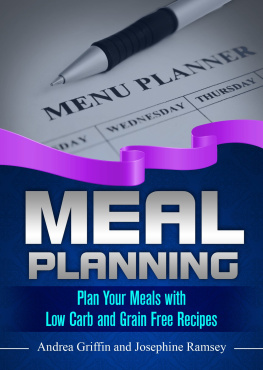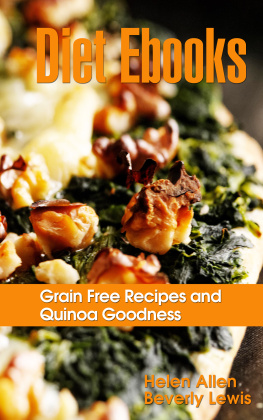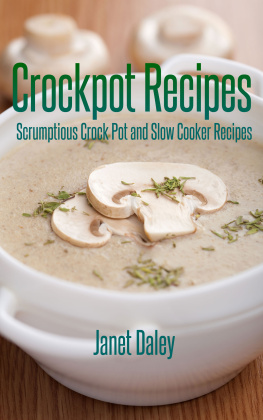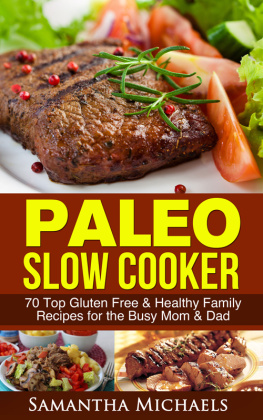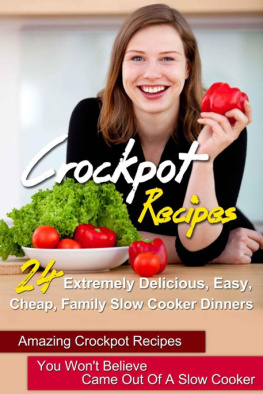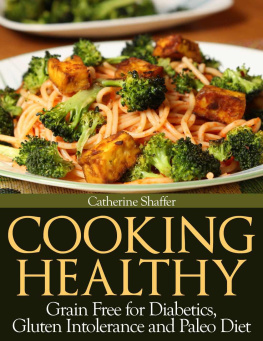Table of Contents
Cooking Light Healthy
Crockpot Goodness and Grain Free Recipes
Carol Lopez and Rose Bennett
Copyright 2013 Carol Lopez and Rose Bennett
All rights reserved.
Introduction
This book is meant for everyone who wants to learn how to cook well and eat in a healthy way. It's here to assist you in creating food that tastes great and makes you feel good. After all, just because something is healthy and light doesn't mean that it has to make you feel deprived or punished.
Whether you already know a little about cooking or you're brand new to it, you'll be able to use the recipes in this book to open up your horizons. If you're an experienced cook, you can use the information and meal options here to change your menus and adjust your assumptions about healthy eating. If you don't know much or anything about preparing food, you'll be able to put together the basics of a health-supporting diet and learn to take care of your own food needs. Over time, you'll develop a repertoire of recipes that will allow you to feed yourself, your family and your friends every single day.
Once upon a time, you might have simply been able to ask an older relative to teach you these basic healthy cooking skills. Now, however, too many of us have gotten used to eating out or using pre-made convenience products to make up our basic diet. Relatively few of us sit down to a real, home-cooked meal, and it's affecting our health and our ability to function with our families.
If you're tired of feeling like you don't have the ability to cook for yourself, these healthy recipes are idea. They'll help you get away from many of the things you've felt forced to rely on. They'll introduce great new flavors and exciting new nutrients. You might even get the chance to try a few cuisines that you've never encountered before. The process can be a little intimidating at first, but if you're willing to check out something new, you'll be happy you took the chance.
Of course, you might wonder why you should bother to learn to cook at all. After all, if you can pick up ready-made meals in the deli section or from your local grocery store freezer, isn't cooking irrelevant? The truth is that when we're not in charge of our own food, we often eat very badly. You might find yourself relying on foods that use lots of heavily-processed grains and sugar. You could end up consuming a lot of trans fatty acids, cholesterol and other unhealthy fats.
It's only when you take control of cooking your own meals that you really gain the ability to manage the things that you eat. You can use less fat, fewer bad processed grains, and a lot more fresh, wholesome ingredients. Think back to the last few days of meals you ate. How many of the ingredients can you name? When you cook your own food, you'll know what went into each and every healthy meal you consume. You'll also find yourself losing weight and feeling a whole lot better.
This book is divided into two separate parts. The first one focuses on grain-free and wheat-free cooking. While there's nothing inherently wrong with consuming grains, many people find that heavily relying on them can be bad for their health. Mixing it up with grain-free cooking can be a great way to improve your health and give your system a rest from the kinds of foods that raise your risk of serious health problems.
The second part of this book is designed just for that part of you that feels you don't have the time to make healthy meals from scratch. If you feel like you could never handle real cooking because your schedule is simply too packed, the crock pot recipes in this section are ideal for your situation. They take a long time to cook, it's true, but they need almost not help from you. All you need to do is prep the dish and place it in the crock pot. The device does the rest, and when you get home, you'll get to enjoy fresh meals that are far healthier than the convenience foods you might have chosen instead.
Learning to go grain-free can help you rule out food intolerances or allergies. It can also be a big help if you already have a sensitivity to modern strains of wheat, corn or other grains. Best of all, this mode of cooking throws you out of the assumption that wheat has to go in everything. You'll still enjoy plenty of delicious, familiar foods, though.
Try out a no-wheat breakfast burrito or coffee cake, Enjoy a snack with oatmeal chocolate chip raisin cookies or spicy Cajun fries. There are even great wheat and grain free breads to make, delicious casseroles to enjoy, and tasty soups, stews and meat dishes. You'll love cooking your own baked salmon, beef stew, stuffed cabbage and gumbo without relying on refined wheat flour and starches. You might be cutting out an ingredient that's incredibly common, but that doesn't mean you have to give up on good food!
Once you've tried a few of the simple, grain-free recipes in the first part of this book, you'll be ready to check out the healthy slow cooker options in the second part. You'll love the way slow-cooked sesame chicken lets you enjoy a Chinese restaurant favorite without high fructose corn syrup or spending a lot of time over a hot stove. You'll also get a kick out of making your own sourdough bread without hours of kneading or putting together an amazing wheat-free caramel rice pudding in just a few minutes of prep time. Turn on the crock pot and come back later for food that's fresh and ready to enjoy.
Get control of your food again with these fresh, healthy recipes. You'll be amazed by the wide variety of fat-burning, health-boosting options you have at your fingertips. Whether you've known how to cook for years or you're just learning, these recipes are here to shake up your table and give you a whole new world of satisfying meals.
Section 1: Grain Free Cookbook
Normally, when people talk about going grain free they mean particularly wheat free. Wheat is found in so many food products today, especially in processed foods. However, the there is a rise in the number of people who experience health issues if they consume wheat, and in particular, the gluten part of the wheat. With the rise of wheat or gluten intolerances and allergies, the need for more alternatives for food has surfaced. First, let's talk about the health issues consuming wheat may cause.
Health Issues From Consuming Wheat
Wheat has a high glycemic index level. This means it converts to "sugar" easily in the body, which in turns converts to excessive weight gain and fat. People wanting to lose weight may find if they avoid wheat, they lose the weight easier.
Allergies to wheat can cause symptoms of IBS or irritable bowel syndrome. Other issues that may show up are migraine headaches, asthma irritations, fatigue, skin issues, and yeast infections. Sometimes people will have one or more of these symptoms and after going off the wheat will find relief. If you have any of these symptoms, you may ask your healthcare provider about having an allergy test done to see if it is caused by wheat. Or try the diet and see if you have relief.
Autism patients may show improvement if they go on a gluten free diet. For parents of autistic children, this is good news, as it may provide some help in treatment. Again, ask the healthcare provider about this possibility.
Some people may have difficulties in the absorption of minerals if they consume wheat. This may be why they show the above symptoms. Certainly, it is best for the body if it is able to absorb all the nutrients from the foods we eat. Going on a grain free diet allows the body to have a chance to absorb all the nutrients from nutritious foods.

